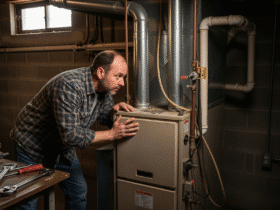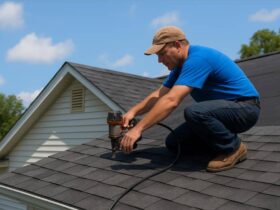Table of Contents
- Why Maintenance Matters for Roof Longevity
- Common Signs Your Roof Needs Attention
- Routine Maintenance Checklist for Homeowners
- How Weather Affects Roof Durability
- DIY vs. Professional Roof Inspections
- Smart Budgeting for Roof Upkeep
- Energy Efficiency Benefits of a Well-Maintained Roof
- Latest Trends in Roof Maintenance
Routine roof maintenance is one of the most effective ways to protect your home from weather-related damage and unexpected repair costs. Roofs are constantly exposed to harsh elements such as rain, hail, wind, snow, and UV rays, all of which can accelerate wear and tear. Even with no visible leaks, severe storms can loosen shingles or flashing, developing minor issues into costly structural problems. Experts recommend conducting professional roof inspections after extreme weather events to identify hidden damage early.
Recent news highlights that the frequency and intensity of storms are rising, leading to a surge in insurance claims for roof damage. Proactive maintenance extends your roof’s life and simplifies the insurance process by providing timely documentation of its condition. It also protects against mold growth, insulation loss, and water infiltration. For homeowners, this habit represents both a preventative and cost-saving strategy. Investing in regular roof evaluations helps preserve your home’s structural integrity and reduces long-term risks tied to weather-related deterioration.
Why Maintenance Matters for Roof Longevity
Roof maintenance isn’t just about improving the look of your home—it’s a critical investment in your family’s comfort and your property’s value. The roof is the first line of defense against wind, rain, sun, snow, and debris. Overlooking its care can result in gradual but significant damage. For many, engaging Sugar Land roofing experts or local professionals ensures minor issues are discovered before they blossom into costly emergencies. Their trained eyes can detect subtle red flags and help you develop a routine prioritizing prevention, safety, and peace of mind.
Many homeowners are surprised to learn that roof neglect is one of the leading factors in premature replacement. Even something as small as a slipped shingle or an unnoticed puncture can invite moisture, weaken structural components, and breed mold over time. The real advantage of ongoing maintenance lies in its preventative power; regular inspections and minor repairs save thousands in future renovation costs, preserve interior air quality, and maintain the structural integrity that supports every room under your roof.
Common Signs Your Roof Needs Attention
Roofing issues rarely announce themselves with a dramatic leak at first—more often, the signs are subtle and gradual. By looking for early symptoms, homeowners can address problems while they’re still manageable. Some indicators include:
- Cracked, missing, or curling shingles disrupting the waterproof barrier
- Dark streaks, stains, or algae growth suggesting prolonged moisture exposure
- Loose, popped, or rusted nails endanger shingle attachment
- Clusters of shingle granules in gutters, signifying material breakdown
- Peeling paint or watermarks on ceilings and upper walls
- Moss buildup in valleys or shaded areas that may retain water
- Visible daylight through attic boards or musty odors upstairs
Each of these signals represents an opportunity for timely intervention. When overlooked, they can escalate into expensive leaks, interior water damage, or even partial roof collapse in severe cases. Being vigilant—especially after significant weather events—can add literal years to your roof’s service life.
Routine Maintenance Checklist for Homeowners
Staying proactive helps your roof withstand years of unpredictable weather and aging. Creating a simple seasonal checklist makes maintenance part of your household routine and heads off common pitfalls:
- Conduct a visual inspection every spring and fall, checking for suspicious spots, missing or warped shingles, and damaged flashing.
- Clear all gutters and downspouts regularly to prevent clogs; blockages almost always lead to water pooling, which can damage shingles and the structure below.
- Trim back overhanging branches that may scrape shingles or drop debris, especially before storm seasons.
- Gently remove moss or algae with a brush or eco-friendly solution, never with a power washer that can erode surfaces.
- Check for rust, corrosion, or breaks in flashing around chimneys, skylights, and vents.
- Address any ice dams promptly after winter storms to prevent seepage under shingles.
- Verify attic vents are clear of insulation, debris, or pest nests to ensure airflow.
- Book a thorough professional inspection at least once yearly, ideally after storm-heavy periods.
This approach elongates your roof’s lifespan and limits any surprise costs. Keeping a digital or paper log of what you checked and when is helpful, so nothing gets overlooked year to year.
How Weather Affects Roof Durability
Severe weather takes a relentless toll on roofs, subjecting them to wind-driven rain, hail impacts, freeze-thaw cycles, and intense UV radiation. Over time, these elements accelerate wear and magnify minor issues into major problems. Experts strongly recommend roof inspections after any extreme weather event—even when leaks aren’t visible—since high winds can dislodge shingles or flashing, and hail may cause structural damage not easily seen from ground level.
Roofing maintenance specialists say proactive checkups help catch vulnerabilities early, preventing water infiltration, mold growth, and structural decay. Recent NPR reports underscore storms becoming more frequent and damaging for property owners nationwide. The surge in insurance claims related to sudden roof damage has highlighted the importance of regular post-storm evaluations.
Conducting timely inspections protects your home’s physical structure and simplifies the claims process by providing updated documentation on roof condition. Staying vigilant allows homeowners to extend the lifespan of their roofs, reduce repair expenses, and maintain a reliable barrier between their living spaces and the elements.
DIY vs. Professional Roof Inspections
Checking your roof from the ground or with a ladder is a smart habit, but it only offers a surface-level view. DIY inspections can help you identify missing shingles, clogged gutters, or visible debris, but they often miss subtle yet serious problems. For instance, a minor sag in your roofline could signal rotting wood beneath, and a small water stain in the attic may point to mold or an active leak. These issues typically require a trained eye and specialized tools to detect. Professional roof inspectors come equipped with safety gear, deep knowledge, and experience to spot structural weaknesses, recommend targeted repairs, and guide preventative care.
In addition to ensuring safety and accuracy, roofing professionals often deliver written inspection reports that are helpful for insurance claims or home sales. They also access areas that homeowners can’t—like under eaves, flashing seams, or ventilation systems. Combining occasional professional evaluations with regular homeowner vigilance is the best strategy to maintain roof integrity, reduce costly surprises, and extend the lifespan of your roofing system.
Smart Budgeting for Roof Upkeep
Budgeting for roof maintenance may seem minor, but the long-term benefits are substantial. Allocating even $20 to $40 per month—or around $200 to $500 annually—can cover essential upkeep like seasonal inspections, gutter cleanings, and minor repairs. These preventive measures help catch small issues early, avoiding the snowball effect that turns affordable fixes into costly replacements. Homeowners who plan for these predictable expenses are less likely to postpone work due to cost, ensuring their roofs remain in good shape year-round.
Another key to smart roof budgeting is understanding your homeowner’s insurance coverage. Review your policy annually to stay informed about what’s covered under storm-related losses. Save all contractor receipts, photos, and maintenance logs—these documents can significantly improve the chances of a smooth and timely claims process after severe weather. When storms hit entire regions, insurers prioritize clear, well-documented cases. Ultimately, consistently investing in routine maintenance pays off by extending roof life, preserving property value, and avoiding the steep costs and stress of emergency replacements or structural damage caused by unchecked wear and tear.
Energy Efficiency Benefits of a Well-Maintained Roof
The condition of your roof plays a crucial role in home comfort and long-term energy efficiency. More than just a protective shell, a properly maintained roof can help regulate indoor temperatures by minimizing heat, cold, and moisture transfer. Key elements like tightly sealed shingles, quality underlayment, and adequate insulation work together to slow heat exchange. This means your home stays cooler during sweltering summers and warmer during frigid winters, easing the load on your HVAC system. Just as important is ventilation; well-designed airflow through the attic prevents heat buildup, which can otherwise seep into living spaces and increase energy demand.
The U.S. Department of Energy consistently emphasizes that even minor roof-related improvements—like patching small leaks, upgrading insulation, or replacing cracked tiles—can cut household energy use by 10–20%. Over the lifespan of a typical roof, these savings can translate into thousands of dollars in reduced utility bills. When viewed through an economic and environmental lens, routine roof maintenance becomes not just a smart home care habit but a long-term investment in sustainability.
Latest Trends in Roof Maintenance
Technology is revolutionizing how homeowners approach roof protection, blending innovation with sustainability to create more innovative, longer-lasting solutions. Today’s advanced roofing systems go far beyond traditional shingles—many now include smart moisture sensors that detect leaks before they cause structural damage, solar-reflective materials that reduce heat absorption and lower cooling costs, and energy-efficient membranes that help insulate the home. Eco-conscious choices are also becoming mainstream, with green roofs and living sedum mats offering natural rainwater absorption, reduced runoff, and pollinator habitat.
Developments like self-healing sealants that automatically reseal minor cracks and extend roof life without manual intervention are equally impressive. Drones now assist with inspections, allowing professionals to detect wear, loose materials, or damage without climbing ladders, boosting safety and efficiency. Composite and recycled roofing materials provide strong, weather-resistant alternatives while supporting environmental goals. These technologies significantly reduce the likelihood of expensive repairs and make routine maintenance more predictable. For homeowners thinking long-term, these innovations enhance property value and appeal to a growing market of eco-aware, tech-savvy buyers looking for resilience and innovative functionality in their homes.










